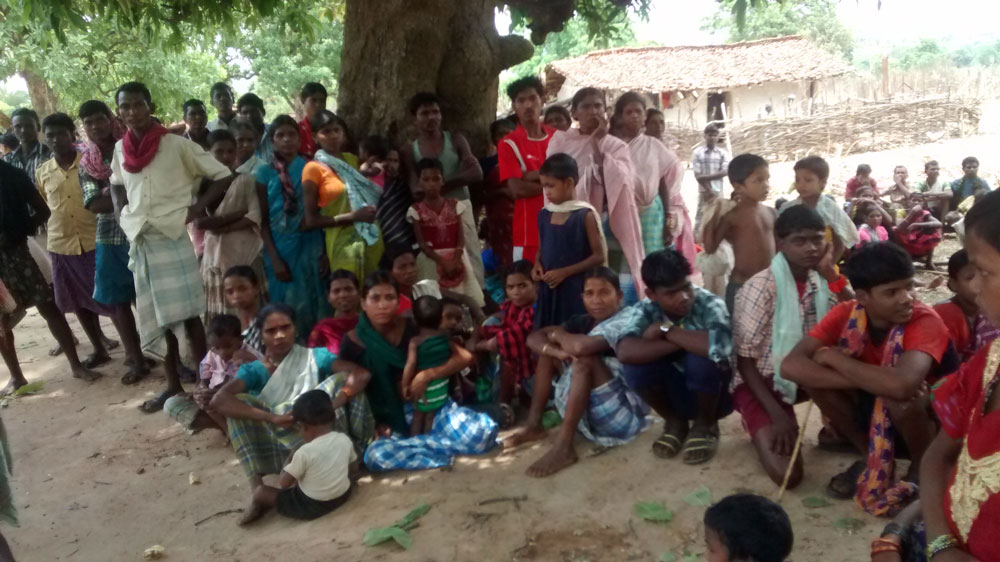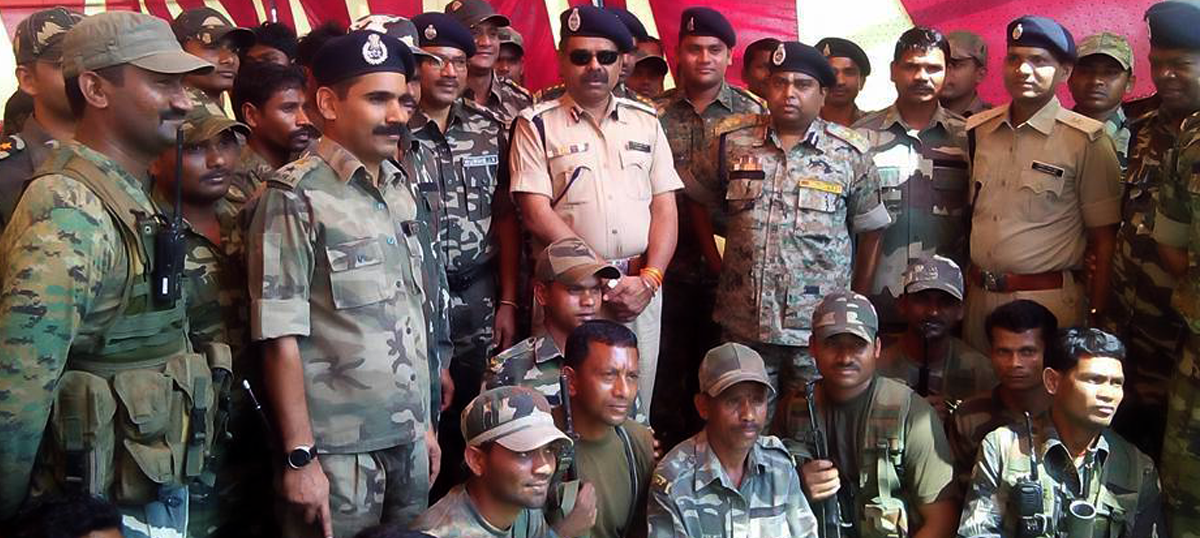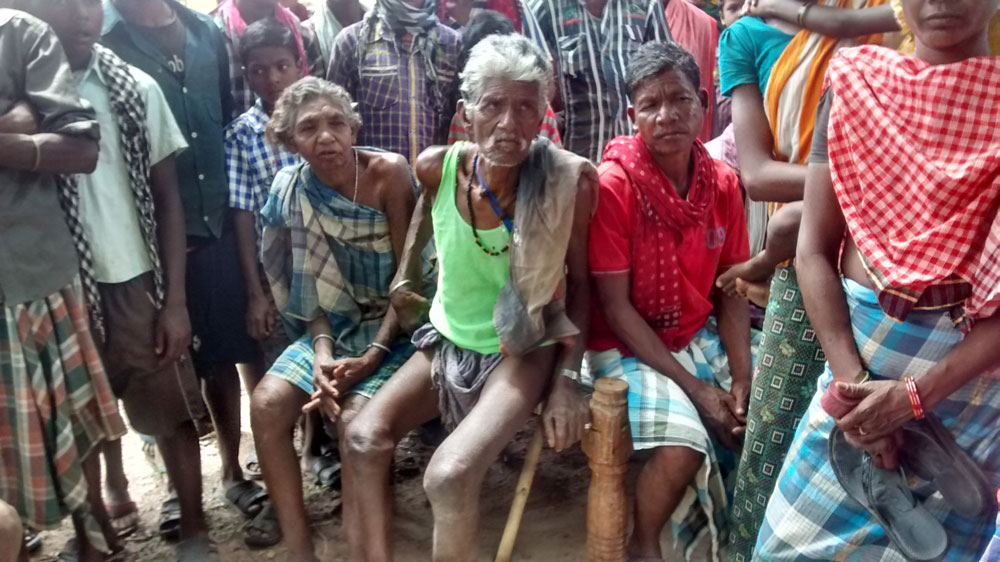It has raised a special unit called the District Reserve Guard, which comprises local adivasi men, many of whom are surrendered Maoists.
During the summer, before the paddy is sown, adivasis in Chhattisgarh often subsist on the small animals and birds they trap in the jungles. On April 11, five men from Bade Gudra village, about 70 kilometers from Dantewada town, went into the Iddesmetta forests that border their village to try to trap a shahi murga, a large rooster that could feed a dozen people.
According to two witnesses, the security men began to shout in Gondi and attacked the five men. They fired at them, leaving one man severely injured. Another man, who managed to escape, told his neighbours what had transpired. In a short while, the security forces came to the village and randomly picked up three other men.
Six of the men, Unga Sori, Unga Kartami, Unga Pudiyami, Kosa Pudiyami, Katti Pudiyami and Raju Manda, are under arrest. Kartam Pandu, 25, managed to escape from his bed in the Civil Hospital in Dantewada even though he had been shot in the leg thrice. He has been missing since.
The men have been charged with being Maoists. “We will only know the exact nature of charges after the challan in the court,” said NK Sahu, the lawyer representing the accused. He expects the Unlawful Activities Prevention Act and the Chhattisgarh Special Public Security Act to be used against them, since these are commonly applied to people accused of being Maoists.
The police claim Pandu, who fled from the hospital, is an inami Naxali, or a Maoist whose arrest would fetch a reward of Rs 1 lakh. But Pandu’s visibly deformed father and frail mother disagree. They said he lived and worked in the village, and was the sole breadwinner in the family. “We asked him to not go into the forest to capture the rooster that day as we wanted him to do other work at home,” said Pande Kartam, his mother. “How I wish he had listened.”
Instances like this have become frequent since last October, as the conflict in Chhattisgarh’s Bastar region has intensified. Arrests of alleged Maoists, surrenders and encounters have seen a significant spurt in the past six months.
Retaliation
Bade Gudra lies just four kilometres off the main road, where seven Central Reserve Police Force jawans in a truck were killed in a blast on March 30. Around 3.30 pm that afternoon, a remotely triggered improvised explosive device went off close to the market in Kuakonda village, right by the vast paddy fields. Five soldiers were killed instantly. Maoists hiding 400 meters away approached the wrecked Tata 407 truck and found two jawans alive. They shot the men at close range and fled.
The jawans, who were part of the 230 Battalion of the Central Reserve Police Force, were on their way to their camp in Bhusaras, a short distance away. “No one expected the attack,” said an official of the CRPF, who spoke on the condition of anonymity since he wasn’t authorised to speak to the press. “It is a huge setback to the force.”
After the attack, security measures have been tightened. When a truck leaves the CRPF camp in Kuakonda to fetch food supplies, it is escorted by armed men riding in two jeeps and five motorcycles.
Another fallout of the attack has been the intensification of security patrols in the area. “We have orders to be as strict as possible with the villages surrounding the area to flush out all Maoists,” said the CRPF official. “The brazen nature of the Maoist attack shocked even senior officials of the force. No one expected the Maoists to come close to the men who were alive and shoot at them.”
In the villages, people said they have not slept in peace since the attack took place. “If they (security forces) come at night, most women sit up awake as they find it too unsafe to sleep when men in uniforms are walking around in the village,” said Paddu Kartami, a 27-year-old resident of Bade Gudra.
Sukko Pudiyami, the wife of Kosa Pudiyami, one of the men arrested on charges of being a Maoist, said: “If they [the security forces] can’t find the Maoists, they trouble us.”
District Reserve Guard
Villagers said the security patrols have continued even after the seven men were arrested from Bade Gudra. Many claimed they could recognise some of the security men.
Pudiyami Rame, a resident of Bade Gudra, who alleged the security forces had beaten her twice in April, identified three of them.“Shankar, Kiran and Badru come to our village repeatedly,” she said. “Each time they come, they beat people up.” The three men, she claimed, worked with the Maoists earlier, and had surrendered to the police in January.
In recent years, Bastar police has been recruiting surrendered Maoists, and placing them in a special unit called the District Reserve Guard, which leads the way for CRPF patrols. “Since these are local youth, people recollect their names very well,” said Isha Khandelwal, lawyer at the Jagdalpur Legal Aid Group. “So, after an incident, they name the DRG youth, giving a cover to the CRPF men.”
While the District Reserve Guard was first raised in Kanker and Narayanpur districts in 2008, Dantewada district acquired its own only last year. The other districts in Bastar region also have their own District Reserve Guards. The combined strength of the force in the seven districts of Bastar is 1,700, according to figures released by the Chhattisgarh government. Another 600 posts were sanctioned in February. In 2015 alone, the District Reserve Guard is said to have carried out 644 anti-Naxal operations, according to a PTI report.
Explaining the rationale of creating a group staffed by local youth, the senior-most police officer in Bastar region, Inspector General SRP Kalluri, told PTI in April: “They are emotionally attached to the region as they belong to this place. They are familiar with the culture, ethos and language of people. Having a bond with the tribals, they are better mentally-conditioned to handle them. They are fighting Maoists efficiently because of their inherent motivation for doing so.”
But others like Soni Sori, the Aam Aadmi Party leader, believe the surrendered Maoists are joining the police simply because there are no other jobs available. Criticising the state’s strategy to create specialised units like the District Reserve Guard, she said: “They are using adivasis to fight adivasis.”
In the villages, the DRG is feared. The residents of Bade Gudra, and the nearby villages of Mailawada, Kuakonda and Palnar, alleged that DRG personnel indulge in looting and indiscriminate beatings.
“When these boys used to come to our village as Maoists, they would ask us for food and other assistance,” said Rame. “But now they beat us up for helping the Maoists.”
“How can we not provide food or water to the Maoists?” she added. “They are all armed.”
Published in: Scroll.in
Published on: 24 May, 2016
Link: https://scroll.in/article/808037/bastar-police-uses-adivasis-to-fight-adivasis-unleashing-violence-in-the-villages




